1 What is the base of the GHO-FM method?
At the GHO-FM method, the follicles are, up to three at a time, removed with minimum impact onto the donor area using a micro driller similar to the dental one with a micro needle of a 0.60 or 0.65mm diameter. At the most removed grafts, a small piece remains at the donor site. The needle diameter is namely smaller than the diameter of the follicular unit containing more follicles. This remaining part then may allow the hair to regrow by, in most cases, containing the so called germ cell of the hair follicle. This way, there is an increased probability of a partial regrowth of the whole follicular unit or its part. Scientific literature calls this phenomenon “The regrowth of the recipient site”. It allows us to retain most of the donor site for later use. The donor site looks, even after more transplantations, aesthetically very acceptable. As the grafts are natural follicular units either by size or by shape, they still retain their natural look.
2 What are the main pros of the GHO-FM method?
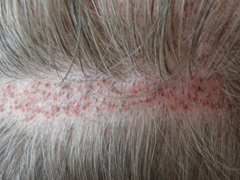 The GHO-FM method brings multiple advantages. From the aesthetic point of view, unlike the classic strip method, the GHO-FM method leaves no visible scar. After the regrowth of the donor site has reached a certain level, it is possible to use it again by the next transplantation. An unmistakable advantage of the GHO-FM method is its unpretentious postoperative convalescence. The donor site heals within 2‒4 days, the recipient site within one week of the transplantation. The openings in the donor area are eventually closed within 8 hours following the follicle extraction.
The GHO-FM method brings multiple advantages. From the aesthetic point of view, unlike the classic strip method, the GHO-FM method leaves no visible scar. After the regrowth of the donor site has reached a certain level, it is possible to use it again by the next transplantation. An unmistakable advantage of the GHO-FM method is its unpretentious postoperative convalescence. The donor site heals within 2‒4 days, the recipient site within one week of the transplantation. The openings in the donor area are eventually closed within 8 hours following the follicle extraction.
3 Does the GHO-FM method achieve better results than the classic one?
The technique of removing the grafts for the transplantation with the GHO-FM method allows us to achieve a more natural-looking result in both the donor and recipient sites. This effect is achieved by using a needle of the same diameter either for the removal of the grafts or the preparation of the recipient site so that the grafts exactly match the openings in the recipient site. In case the procedure is performed in a well established facility, it is possible to achieve high-quality results even with the older type of transplantation. In 1996, the head surgeon of PANACEA HAIR CLINIC, Peter Hajduk, MD., also started with the strip method and continued performing it until 2003. In this period, he transplanted hair in more than 2000 patients.
4 New information have emerged recently that there is a new transplant method using an automatic device for the collection and planting of grafts. Is this method similar to the GHO-FM?
It is certainly not a new method. Attempts at similar solutions are older than ten years. A device performing this technology has appeared in the last five years. The PANACEA HAIR CLINIC, has been approached and asked to buy this device on several occasions. After considering the pros and cons, and after discussions with specialists abroad whoʼve been running hair transplantations for many years, we have come to the conclusion that for the client as for the end user of the technology, this doesnʼt bring anything new or positive in comparison to GHO-FM method. Maybe just a shortening of the operation time in tens of minutes. You can convince yourself that none of the leading centres performs this technique. The reason is mainly that nothing can replace the delicate human hand, eye and brain in the selection of grafts, so as the estimate where to pick and where to leave. Nothing can also substitute the coordination of hand when planting the grafts, when setting the correct inclination, the angle and direction. No machine can do it. Despite the significantly higher graft manipulation within the system. But the most important difference is considered to be the size of the collection needle. The device uses needles of almost doubled size in comparison for example with a collection needle used at PANACEA HAIR CLINIC. The size of needles is the factor proving the greatest influence on the regeneration of donor sites. And, the time difference between four or five hours spent on the operation room at operations that costs tens of thousands of Crowns and may change the clientʼs look for the rest of life, is considered by the team PANACEA HAIR CLINIC entirely irrelevant and misguided. If this technology was indeed the "gold standard", as some facilities are trying to persuade the unsuspecting uninitiated, then they would have been introduced by facilities and surgeons like Bosley Medical, DHI, Moser, GHO, Cole, Jones, Shapiro, Rassman, Kolasinski, Farjo, Cooley, Haber and other world clinics would have long had it in their portfolio. The opposite is true. These devices have been presented at world forums but there are practically no lectures showing and presenting their results or introducing clinics where the device is used. It's always good when the client has a choice. However, the choice should be made with reason, under no stress and with regard to the fact that the intervention will change your life.
5 Is the procedure painful?
During the single procedures of removal, preparation of the recipient site or the implantation of the grafts, the patient does not feel anything. You might experience the only discomfort during the application of local anaesthetics into the skin in the donor and recipient areas. But we try to decrease this by cooling of the area and by using a special anaesthetic cream, used also for example when applying laser on human skin. Even though the patients don’t usually feel pain after the treatment, they are provided with painkillers when leaving the clinic.
6 How thick will be my new hair?
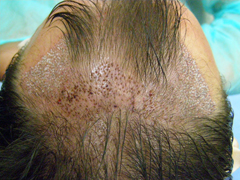 The thickness of your new hair depends on two factors ‒ the number of grafts that can be removed and the size of the recipient area where they are implanted. The bigger the area, the lower the thickness of your new hair. Theoretically, the shortest distance of the grafts is 1.3 millimetre. Practically, the commonly achieved density of grafts is 40 grafts a square centimetre. Actually, we are talking about grafts, not hair. One graft contains more hair follicles and that is why the above mentioned density at the recipient site is enough for a good aesthetic result. We often discuss with clients, if it’s better to have bigger thickness or to have the hair spread over a big area. Mostly we choose a compromise by which we satisfy the client as the hair thickness in question can be achieved with additional transplantations.
The thickness of your new hair depends on two factors ‒ the number of grafts that can be removed and the size of the recipient area where they are implanted. The bigger the area, the lower the thickness of your new hair. Theoretically, the shortest distance of the grafts is 1.3 millimetre. Practically, the commonly achieved density of grafts is 40 grafts a square centimetre. Actually, we are talking about grafts, not hair. One graft contains more hair follicles and that is why the above mentioned density at the recipient site is enough for a good aesthetic result. We often discuss with clients, if it’s better to have bigger thickness or to have the hair spread over a big area. Mostly we choose a compromise by which we satisfy the client as the hair thickness in question can be achieved with additional transplantations.
7 What will I be able to do with my new hair?
The first two weeks after the transplantation, you should avoid mechanical, chemic or solar irritation. After this time you can do with your new hair whatever you want but you shouldnʼt dye your hair earlier than 4‒6 weeks after treatment. What you do with your new hair is your business but remember it is your hair and only you can affect its future growth and quality.
8 How long will I have to take to see the results?
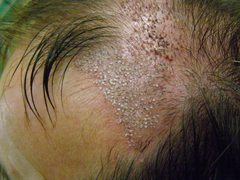 The hair starts growing right after the transplantation, but this is only a temporary situation. Then, a period comes, when the follicles may loose the old, original hair and the grafts might fall out so, after about 2 months, the patient may experience a feeling, that the process went wrong and everything is lost. Fortunately it is not. This stage is only a part of the normal biological process. After three months following the operation, new permanent hair starts showing up. The final effect is visible 10 to 12 months after the transplantation, in some cases even later. It is normal as every follicle has its own lifecycle.
The hair starts growing right after the transplantation, but this is only a temporary situation. Then, a period comes, when the follicles may loose the old, original hair and the grafts might fall out so, after about 2 months, the patient may experience a feeling, that the process went wrong and everything is lost. Fortunately it is not. This stage is only a part of the normal biological process. After three months following the operation, new permanent hair starts showing up. The final effect is visible 10 to 12 months after the transplantation, in some cases even later. It is normal as every follicle has its own lifecycle.
9 How long does the procedure take?
The GHO-FM method is relatively demanding in terms of work and time as natural grafts are removed and transplanted every single one after another. A team of 2‒3 experienced medical experts works with the patient for 3‒6 hours, depending on the number of grafts transplanted. The whole transplantation is performed under local anaesthetics and can be interrupted when needed. In the middle of the procedure, as soon as the hair follicles have been removed, there is always a 25 minute refreshment break. After the procedure, the client should stay at a patient room for some tens of minutes to make sure everything has gone alright. Only after that, the client can leave the clinic.
10 Can I cover the costs with my health insurance?
Unfortunately, according to our information, health insurance companies do not cover operations of this type, even if the hair loss was caused by an injury. In case the reason of hair loss is an oncological treatment, a resolution always depends on the medical advisor of the insurance group in question but our experiences are negative.
11 Is there an age limit for the GHO-FM method?
No, there isn’t. The health condition of the patient is the crucial factor. With regard to the gentle nature of the operation the method is suitable for all age groups. We have already transplanted hair on a number of patients younger than 18 years, always because of health purposes, mostly because of their carcinologic treatment. Our actually oldest patient was 75 years old. The only condition for the transplantation is the ability to lay on your stomach or side for 1‒3 hours
12 How many grafts and/or treatments will I need?
The number of grafts (or operations) needed to achieve a satisfactory result varies and is highly individual. It depends on the size of the recipient area, the quality of hair, its colour, structure, the quality of skin. For small areas or a small or medium extent of alopecia, one treatment is usually enough, but larger recipient areas or request for higher hair thickness may lead to further transplantations which may be performed at least after six months. At a higher number of grafts, the operation may be performed sometimes even several days running. This way, more than 3000 grafts can be transplanted within 2‒3 days. It is possible to remove hair from a high-quality donor area even more times but this may be done after an interval of one year.
13 Won’t the new hair fall out after some time? Will it last at least 20 years?
The hair used for hair transplantation is removed from the so called genetically safe area, which means it keeps growing for the rest of your life and never falls out even after 20 years. It is your best hair with the highest quality. At our clinic, we check the quality of your hair by a trichological examination, which is recommended to everyone thinking about hair transplantation. We have a trained expert, a dermatologist, who performs a ca. 40 minute-long examination. The results will be electronically sent to you following the examination and assessed during your consultation.
14 How much transplantations are needed to eliminate alopecia?
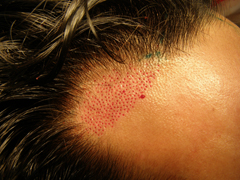
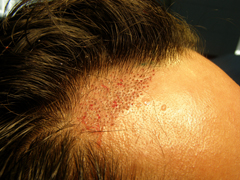 The hair implantation caused by alopecia represents about 30% of all hair transplantations. The number of grafts needed is approximately 300 to 800 depending on the size of the recipient area, the colour of your hair, its structure, and your current hair style. Mostly, it takes just one procedure and about a year later we can increase the thickness. This happens mainly, if the original hair kept on falling out, which we must count with.
The hair implantation caused by alopecia represents about 30% of all hair transplantations. The number of grafts needed is approximately 300 to 800 depending on the size of the recipient area, the colour of your hair, its structure, and your current hair style. Mostly, it takes just one procedure and about a year later we can increase the thickness. This happens mainly, if the original hair kept on falling out, which we must count with.
15 Are any examinations needed before the transplantation?
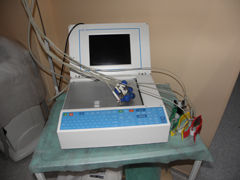
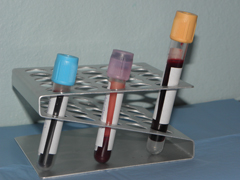 Yes there are, even if the procedure takes place in local anaesthesia we must, along with the law, insist on a so called internal preoperational examination. This is to make sure that the patient has no conditions that could be a threat to the procedure, to the following convalescence of the patient but moreover to the patient’s health and life (allergy, hidden diseases, increased bleeding, cardialgia, etc. The examination itself, consisting of an ECG and a blood and urine test, can be performed at the clinic. The client will pay approximately 800 CZK for it. You can also undergo it at your general practitioner’s.
Yes there are, even if the procedure takes place in local anaesthesia we must, along with the law, insist on a so called internal preoperational examination. This is to make sure that the patient has no conditions that could be a threat to the procedure, to the following convalescence of the patient but moreover to the patient’s health and life (allergy, hidden diseases, increased bleeding, cardialgia, etc. The examination itself, consisting of an ECG and a blood and urine test, can be performed at the clinic. The client will pay approximately 800 CZK for it. You can also undergo it at your general practitioner’s.
16 Is it possible to get an accommodation at the clinic or nearby and to fix up transport for me?
Daily, we have at least three hotel-type patient’s rooms available, so there is no problem of assuring accommodation for non-Prague residents for the night following the procedure. The rooms are equipped with a shower, toilet, a TV and satellite. The price including breakfast is 1 300,- CZK/day. In case you preferred accommodation outside the clinic, we can recommend you the Hotel VOYAGE which is situated within striking distance of our clinic so it can offer you full comfort during your use of our services as well. The transport of the client to/from the airport and around Prague, we can provide you with a car with our driver.
17 What written guarantees do you give for your work?
Before the procedure, the clinic and the client sign a contract. The contract specifies the clinic's obligations, in particular for certain treatments, and its liability for them. In fact, it means that the clinic is bound, in case of any damage caused by their mistake or ill growth of the hair, to either to stimulate the hair growth with a further operation free-of-charge or to refund the client in an adequate amount.
18 Is it possible to transplant hair (body hairs) from other parts of the body than the head?
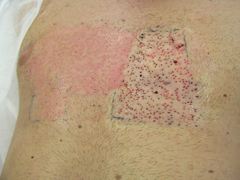 Yes it is, our clinic performs the “body hair transplantation” which is a very gentle removal of hair follicular units. The technique leaves no scars, so we can remove hair from the chest, belly, legs or even face of our patients. Body hair transplantation is mostly used at transplantations of eyebrows, barbs and batches, where the donor area on the head isn't of a good quality, because of injuries, or past transplantations /mainly because of the older strip method or the method of follicle extraction through large punches/. With regard to the high work-demand of this procedure and lower density of the body hairs, less grafts can be withdrawn at once than they could be withdrawn in the head. Maximum number of grafts is 500 per one session.
Yes it is, our clinic performs the “body hair transplantation” which is a very gentle removal of hair follicular units. The technique leaves no scars, so we can remove hair from the chest, belly, legs or even face of our patients. Body hair transplantation is mostly used at transplantations of eyebrows, barbs and batches, where the donor area on the head isn't of a good quality, because of injuries, or past transplantations /mainly because of the older strip method or the method of follicle extraction through large punches/. With regard to the high work-demand of this procedure and lower density of the body hairs, less grafts can be withdrawn at once than they could be withdrawn in the head. Maximum number of grafts is 500 per one session.
19 Is it possible to transplant hair (body hairs) elsewhere than onto the head?
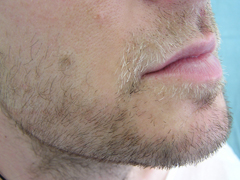 Yes, it is. It is possible to transplant hair everywhere where it previously was, for example barbs, eyebrows, eyelashes, body hair on arms, the chest, pubic hair and hair in the area of forelocks.
Yes, it is. It is possible to transplant hair everywhere where it previously was, for example barbs, eyebrows, eyelashes, body hair on arms, the chest, pubic hair and hair in the area of forelocks.
20 Is the procedure repeatable? What are the necessary intervals?
The fact that the same donor area ca be used more times without the creation of scars makes up the most important advantage of the GHO-FM method. It is also possible to divide the procedure into more stages without the risk of multiple scars for each stage, as it was at the older transplantation methods. We usually divide the whole procedure into stages according to the financial possibilities of the client. In case another site on the scalp is treated, the same procedure can be repeated the following day, e.g. first, the alopecia may be treated and then, the vertex may be treated the other day. Single treatments of a certain site should be performed with an interval of at least six months, best after one year from the original procedure. The reason is namely the hair growth and follicle regeneration of the donor site.
21 Is the transplantation also possible for women?
Yes, it is. We have been performing hair transplantations in women many years. The indications are similar to the men ones, however, hair loss in women proceeds according to a different graphical picture. In most cases, the reason of hair loss may be a serious metabolic disease (thyroid gland, adrenals etc.). The per cent of women coming to a consultation preceding an operation is increasing every year. In 2010 it was about 22% of the consultations and 13% of the transplantations. Women are extremely disciplined clients who usually show a significant satisfaction with the results.
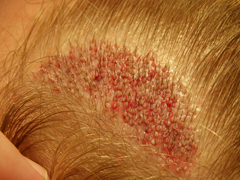 |
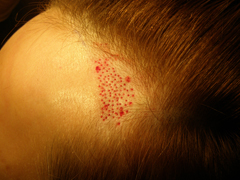 |
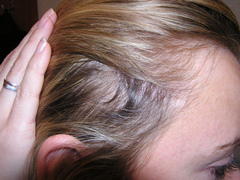 |
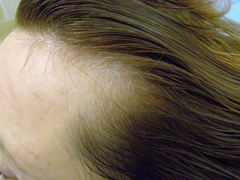 |
22 Is it possible to transplant eyebrows?
Yes, it is. Our GHO-FM method is very appropriate for eyebrow reconstruction or transplantation, mostly because the technique of graft extraction leaves no scars. This way, we can extract the grafts from any parts of the body, not only from head. By this, we can get the most realistic hair (hairs) to imitate eyebrows. Mostly, the hair is extracted from the hairy part of the head, as we can get the best spread there. Also, the eventual effect is then very natural due to the shape of the graft. We have already transplanted eyebrows after burns, car accidents or chronic eyebrow uprooting. One side usually needs about 100 to 200 grafts. It is possible to make it during one or more treatments, depending on the client. The treatment strategy should be settled personally during a preliminary consultation with the surgeon. In relation to the number of grafts, one treatment can take two to three hours.

